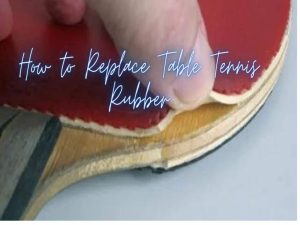It is important to get the most use out of your paddle after you have found one that suits your playing style and hand size. Table tennis rackets typically feature replacement rubbers that can be easily swapped out whenever the rubbers become worn or damaged, allowing you to continue using your favorite paddle for as long as possible.
In this post, we will discuss the reasons why you may want to consider replacing your paddle’s rubber. Here, we’ll walk you through the steps.
Your paddle’s rubber needs to be changed, but why?
Over time, rubber surfaces change and deteriorate. If the rubber on your table tennis paddle does not maintain its quality and elasticity, the ball will not be able to be struck with speed, accuracy, or spin. You may need to replace the rubber on your table tennis paddle for several reasons, but here are some of the more common reasons:
Damaged Rubber
The rubber on a table tennis racket is temporary for avid players. It wears out over time and has to be replaced regularly because it wears out over time. A new version of rubber, for example, might be a good reason to change rubber. You can also change the rubber if you find a rubber that’s better for your particular situation, for example. A player will rarely switch rubber types after playing with one rubber type for a while. Changing from inverted to pip format, for instance.
Your rubber will peel off over time as the glue holding it to the blade wears off. It will not take long before the rubber is completely gone and you may have to replace it. If it’s coming off, you can get table tennis glue to adhere it back on. You might need to replace the rubber’s pips over time if the pips are crushed or have come off completely.
Degradation of the Rubber
A table tennis paddle’s rubber layer will break down over time as a result of the rubber and sponge rubbing against each other. Changing your rubbers is also a good idea if you notice uneven bounces, spins, or areas where the surface is not as firm.
Rubber needs to be improved or upgraded
Rubber and sponge play a huge role in controlling your racket as well as generating power. It may be beneficial to upgrade to a new rubber to enhance one of those if you want to enhance one of them. For players to have more options when choosing their shot, they will often select different types of rubber for each side of the paddle.
If you are replacing the rubber, Make sure the new rubber has the same thickness and that you use the same glue and glue procedure if you are replacing the worn-out rubber.
You’ve got a new table tennis blade
The rubbers will need to be added by you if you want to build your own custom bats. Replacing rubbers is the same process, except that you won’t need to remove the old ones. Is it time to replace your blade?
Table tennis rubber replacement frequency
Table tennis players need to replace their rubbers periodically due to inevitable damage or degradation. Approximately 60 hours of play should be required to replace ping pong rubbers for the average player. Hours are clocked differently for each player based on their frequency of gameplay.
Rubbers should be changed often based on:
- How much do you play Rubbers will be subjected to a great deal of wear and tear over the course of time-based on this factor.
- What kind of care do you give to your paddle The lifespan of a rubber can be decreased by heat, cold, UV light, dust, and dirt.
- It depends on your experience level. In order to determine what works best for their style of play, intermediate players often try different rubbers.
- Spongy Texture Loss: Slide your forefinger across the paddle’s rubber surface in different directions. A rubber replacement is necessary if it feels more spongey on the edges than in the middle.
- Fading color: Ping pong rubber loses its elastic properties and tacky texture as it ages, resulting in faded colors. The rubber on your paddle may have become old and should be replaced if it has uneven color.
- Rubber cracks – A paddle that has visible cracks is in need of a surface change and should be replaced.
- Inconsistent shots – There is a possibility that shots will not always land in the intended direction on an uneven rubber surface.
It is recommended that most casual table tennis players replace their table tennis rubbers about once a year, whereas those who play frequently may need to do so every few months. In any case, where the rubber shows any signs of damage or its performance changes, it should be replaced immediately.
Pieces of equipment are required to change the table tennis rubber.
The first thing you need is a table tennis paddle with replaceable rubber. Various types of paddles use “permanent” rubber, which cannot be replaced. This should only be attempted if you have the option to replace it.
To replace the rubbers on your paddle, you will need the following:
- The new rubbers you must have
- A Glue, Designated for sticking the table tennis rubber.
- Using a rolling pin or hard brayer
- Glue application tools (such as sponges)
- Craft or utility knives or a pair of sharp scissors 4
How To remove old table tennis rubber
Using a very gentle and careful approach, peel the old rubber off along the entire surface of the blade. The skin should be peeled away slowly, not ripped, and with gentle, even pressure, in a peeling motion rather than ripping. Check the blade for cleanliness and smoothness once the old rubbers have been removed. Rub or scrub it away if there is any glue left over. Glue residue left over from a damaged blade can be removed by using soft sandpaper; a severely damaged blade should be replaced.
Instructions for the application of new rubber
The new rubbers can be applied once your blade has been cleaned and prepared. The steps are as follows:
1-One of your rubbers should be covered with a thin layer of glue.
2-The glue should be applied in a thin, even layer using a sponge, brush, or credit card. Ensure the glue coat is even by taking your time.
3-After applying a layer of glue to the blade, allow the rubber to sit for a few minutes.
4-If the glue layer on the blade isn’t thin or even, use the sponge or brush to make sure it’s thin.
5-You will need to wait until the glue dries on both sides until it is tacky and sticky to the touch, however, it should not be wet. Typically, this process takes 5 to 10 minutes for rubber. Typically, it takes 3-8 minutes to dry the blade, but check your glue’s instructions for the best drying time.
6-A good way to align the rubber bottom edge with the blade bottom edge is to align the rubber bottom edge. You should center your logo over the blade’s bottom if your rubber has one.
7-Press the bottom edge of the rubber into place while curling the rubber up away from the surface.
8-As the rubber is unrolled, make sure there are no air bubbles on the blade.
9-Replace the rubber by smoothing and pressing it in place.
10-The rubber should be pressed and smoothed with a rolling pin or brayer.
11-Once the rubber edges have been trimmed to the edge of your blade, use a craft knife to finish them off.
12-The another side of the paddle should be done in the same manner.
You should consider using a blade sealant if you are frequently replacing your blades and use water-based glue. The surface of the paddle is protected and preserved by a coating of sealant that protects it from repeated peeling and gluing. You can visit: how to seal a ping pong paddle.
How to seal the ping pong paddle, Please use the link https://www.pingpongbay.com/seal-a-table-tennis-blade/
Conclusion
If your rubbers need to be replaced, you are free to keep using the paddle of your choice as you replace or upgrade your rubbers as necessary. Your game will remain competitive if you use your equipment this way.
Keep in mind that not all paddles can be replaced with rubber. Rubbers can’t be removed from some beginner’s rackets since they’re designed for beginners. You’ll need to purchase a new bat if your bat cannot have new rubbers put on it.
Frequently Asked Questions
How Often To Replace Table Tennis Rubber
Mostly, Top player’s change the rubber after about 6-7 days of full practise.
What Type of Glue Can Be Used For Table Tennis Rubber?
Water based glue is primarily used and is all you need. Apply thin coat to the blade and rubber sheet and let both of them dry.
How Long Does A Table Tennis Rubber Lasts
Average life of table tennis rubber is 75-100 hours of playing.Mostly table tennnis players replce the rubber between 6-12 months.
What Happened To Rubber When Rubber Gets Old
The strength and flexibility of the rubber may change when it gets old.

